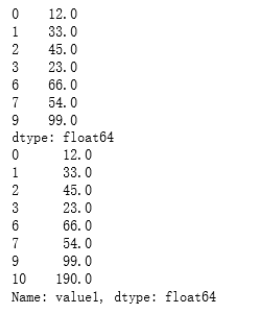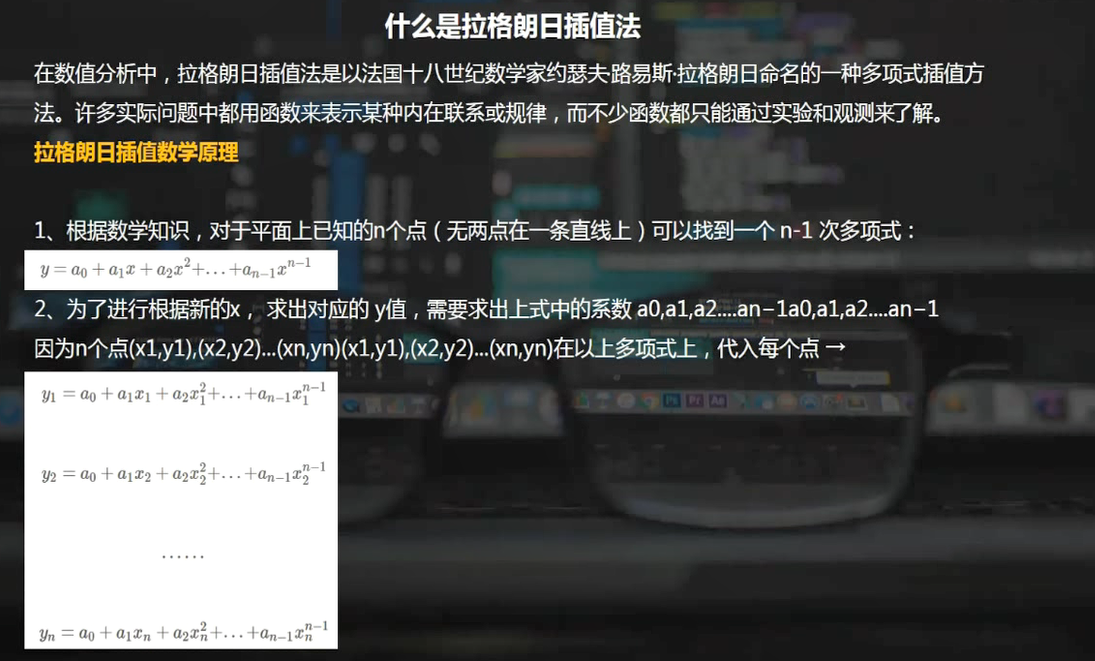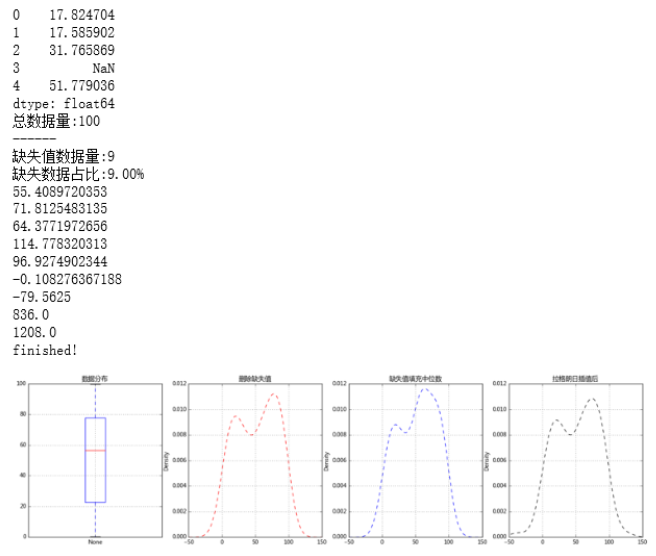数据处理—缺失值处理
数据缺失主要包括记录缺失和字段信息缺失等情况,其对数据分析会有较大影响,导致结果不确定性更加显著
缺失值的处理:删除记录 / 数据插补 / 不处理
1,删除记录
判断是否有缺失值数据 - isnull,notnull
notnull:缺失值为False,非缺失值为True
import numpy as np
import pandas as pd
import matplotlib.pyplot as plt
from scipy import stats
% matplotlib inline
s = pd.Series([12,33,45,23,np.nan,np.nan,66,54,np.nan,99])
df = pd.DataFrame({'value1':[12,33,45,23,np.nan,np.nan,66,54,np.nan,99,190],
'value2':['a','b','c','d','e',np.nan,np.nan,'f','g',np.nan,'g']})
# 创建数据
print(s.isnull()) # Series直接判断是否是缺失值,返回一个Series
print(df.notnull()) # Dataframe直接判断是否是缺失值,返回一个Series
print(df['value1'].notnull()) # 通过索引判断
print('------')
s2 = s[s.isnull() == False]
df2 = df[df['value2'].notnull()] # 注意和 df2 = df[df['value2'].notnull()] ['value1'] 的区别
print(s2)
print(df2)
# 筛选非缺失值

删除缺失值 - dropna
s = pd.Series([12,33,45,23,np.nan,np.nan,66,54,np.nan,99])
df = pd.DataFrame({'value1':[12,33,45,23,np.nan,np.nan,66,54,np.nan,99,190],
'value2':['a','b','c','d','e',np.nan,np.nan,'f','g',np.nan,'g']})
# 创建数据
s.dropna(inplace = True)
df2 = df['value1'].dropna()
print(s)
print(df2)
# drop方法:可直接用于Series,Dataframe
# 注意inplace参数,默认False → 生成新的值

填充/替换缺失数据 - fillna、replace
s = pd.Series([12,33,45,23,np.nan,np.nan,66,54,np.nan,99])
df = pd.DataFrame({'value1':[12,33,45,23,np.nan,np.nan,66,54,np.nan,99,190],
'value2':['a','b','c','d','e',np.nan,np.nan,'f','g',np.nan,'g']})
# 创建数据
s.fillna(0,inplace = True)
print(s)
print('------')
# s.fillna(value=None, method=None, axis=None, inplace=False, limit=None, downcast=None, **kwargs)
# value:填充值
# 注意inplace参数
df['value1'].fillna(method = 'pad',inplace = True)
print(df)
print('------')
# method参数:
# pad / ffill → 用之前的数据填充
# backfill / bfill → 用之后的数据填充
s = pd.Series([1,1,1,1,2,2,2,3,4,5,np.nan,np.nan,66,54,np.nan,99])
s.replace(np.nan,'缺失数据',inplace = True)
print(s)
print('------')
# df.replace(to_replace=None, value=None, inplace=False, limit=None, regex=False, method='pad', axis=None)
# to_replace → 被替换的值
# value → 替换值
s.replace([1,2,3],np.nan,inplace = True)
print(s)
# 多值用np.nan代替

2,缺失值插补
几种思路:均值/中位数/众数插补、临近值插补、插值法
(1)均值/中位数/众数插补
s = pd.Series([1,2,3,np.nan,3,4,5,5,5,5,np.nan,np.nan,6,6,7,12,2,np.nan,3,4])
#print(s)
print('------')
# 创建数据
u = s.mean() # 均值
me = s.median() # 中位数
mod = s.mode() # 众数
print('均值为:%.2f, 中位数为:%.2f' % (u,me))
print('众数为:', mod.tolist())
print('------')
# 分别求出均值/中位数/众数
s.fillna(u,inplace = True)
print(s)
# 用均值填补

(2)临近值插补
s = pd.Series([1,2,3,np.nan,3,4,5,5,5,5,np.nan,np.nan,6,6,7,12,2,np.nan,3,4])
#print(s)
print('------')
# 创建数据
s.fillna(method = 'ffill',inplace = True)
print(s)
# 用前值插补

(3)插值法 —— 拉格朗日插值法

from scipy.interpolate import lagrange
x = [3, 6, 9]
y = [10, 8, 4]
print(lagrange(x,y))
print(type(lagrange(x,y)))
# 的输出值为的是多项式的n个系数
# 这里输出3个值,分别为a0,a1,a2
# y = a0 * x**2 + a1 * x + a2 → y = -0.11111111 * x**2 + 0.33333333 * x + 10
print('插值10为:%.2f' % lagrange(x,y)(10))
print('------')
# -0.11111111*100 + 0.33333333*10 + 10 = -11.11111111 + 3.33333333 +10 = 2.22222222

(3)插值法 —— 拉格朗日插值法,实际运用
data = pd.Series(np.random.rand(100)*100)
data[3,6,33,56,45,66,67,80,90] = np.nan
print(data.head())
print('总数据量:%i' % len(data))
print('------')
# 创建数据
data_na = data[data.isnull()]
print('缺失值数据量:%i' % len(data_na))
print('缺失数据占比:%.2f%%' % (len(data_na) / len(data) * 100))
# 缺失值的数量
data_c = data.fillna(data.median()) # 中位数填充缺失值
fig,axes = plt.subplots(1,4,figsize = (20,5))
data.plot.box(ax = axes[0],grid = True,title = '数据分布')
data.plot(kind = 'kde',style = '--r',ax = axes[1],grid = True,title = '删除缺失值',xlim = [-50,150])
data_c.plot(kind = 'kde',style = '--b',ax = axes[2],grid = True,title = '缺失值填充中位数',xlim = [-50,150])
# 密度图查看缺失值情况
def na_c(s,n,k=5):
y = s[list(range(n-k,n+1+k))] # 取数
y = y[y.notnull()] # 剔除空值
return(lagrange(y.index,list(y))(n))
# 创建函数,做插值,由于数据量原因,以空值前后5个数据(共10个数据)为例做插值
na_re = []
for i in range(len(data)):
if data.isnull()[i]:
data[i] = na_c(data,i)
print(na_c(data,i))
na_re.append(data[i])
data.dropna(inplace=True) # 清除插值后仍存在的缺失值
data.plot(kind = 'kde',style = '--k',ax = axes[3],grid = True,title = '拉格朗日插值后',xlim = [-50,150])
print('finished!')
# 缺失值插值

